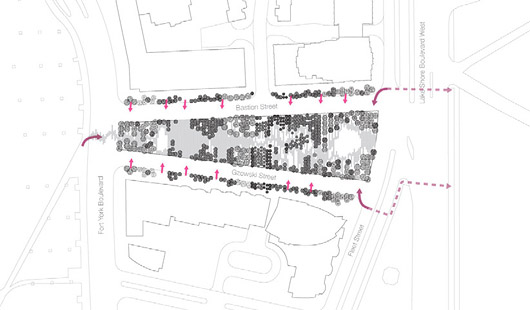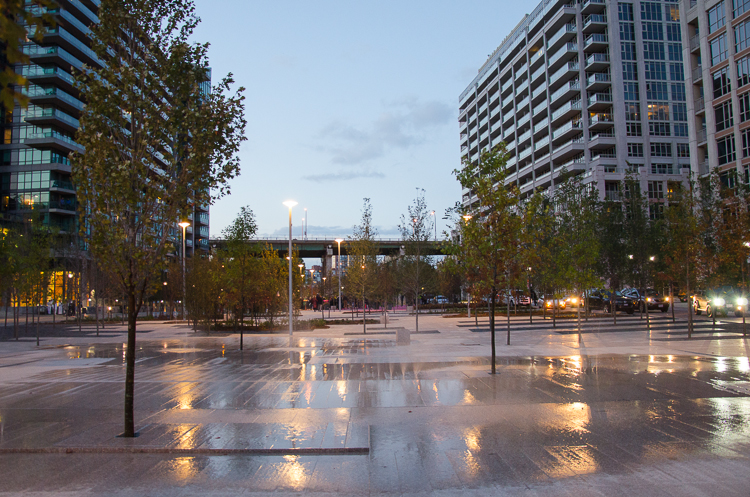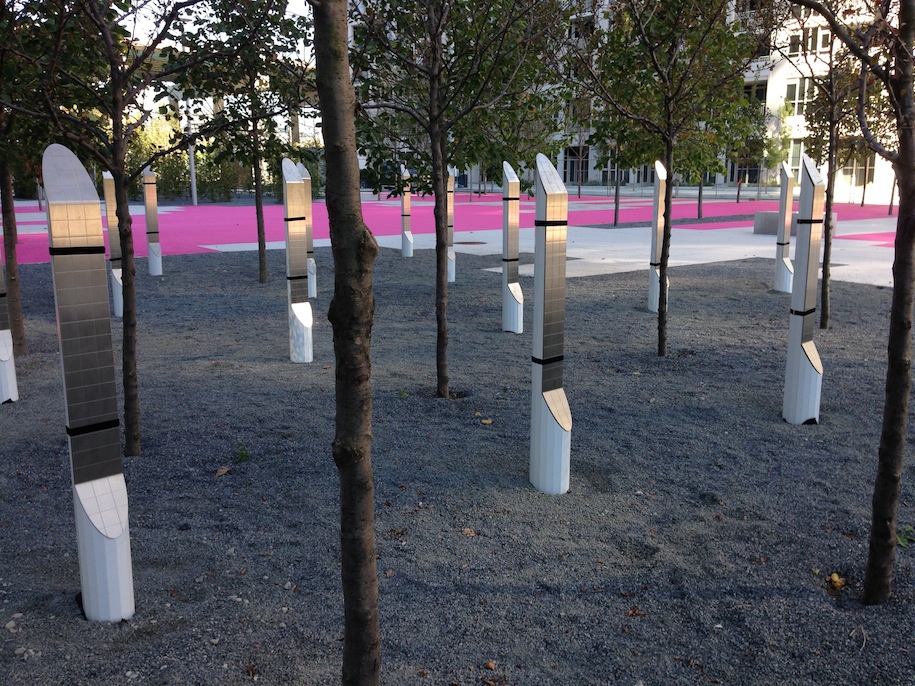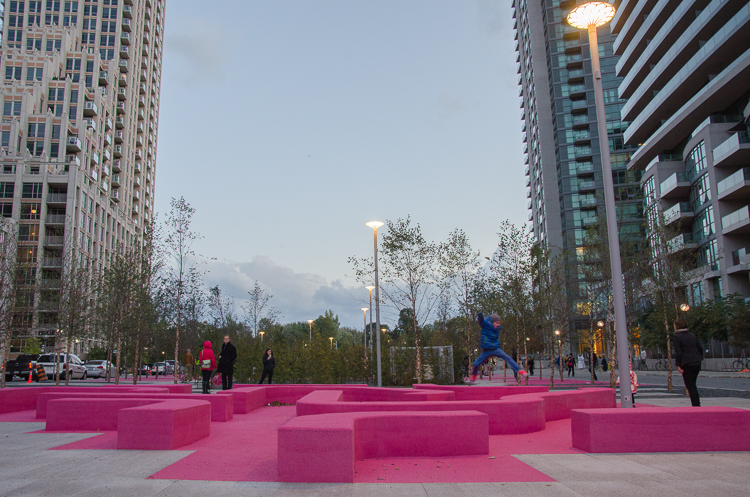A version of this post appeared in the October 6th edition of UrbanToronto.

There’s a new kid on the block. And it’s kid-friendly too. On Saturday October 4th, Fort York neighbourhood residents and those from beyond gathered to welcome a much-anticipated public space at its heart: a new urban park with a richly varied forest and striking pink covering. June Callwood Park injects colour and a dose of street life into the urban landscape.
The festivities celebrated the opening of the park and the legacy of June Callwood, one of Canada’s leading social activists who passed away in 2007. Coinciding with the kick-off of the all-night art crawl Nuit Blanche, City of Toronto officials in partnership with the Garden Club of Toronto welcomed the gatherers. Following a short speech by Callwood’s daughter, author Jill Frayne, and an appropriately floral ribbon-cutting ceremony, local art group Shadowlands Theatre engaged the crowd in a performative experience, leading visitors through an interactive tour of the park’s features.
The park is located amidst a quadrant of tall condo buildings on a wedge-shaped corridor spanning from Fort York Boulevard to Fleet Street. It is a key element in reconnecting the Fort to the Lake Ontario shoreline, which has incrementally moved south with infilling over the decades. The area has seen rapidly increasing residential density —including a growing number of kids— and, most recently, has garnered additional attention with the unveiling of the Fort York Visitor Centre.
Dedicated in 2005, the new 0.4-hectare park honours Callwood’s role in the development of social aid organizations and her fervent championing of children’s causes, through its design and art installation. The design, by Toronto-based multidisciplinary firm gh3, was the result of an open, two-stage international competition, which included extensive public consultation led by the City’s Parks, Forestry and Recreation division.
It was a visual representation of the words of Callwood that formed the basis of the winning design. During one of her final interviews she was asked if she believed in God or in the afterlife. Her response, “I believe in kindness,” is a physically mapped voiceprint whose undulations create a path running north to south through the park, with an abstract geometric pattern of clearings within the groves. It is a contemporary urban vision of a park and garden.
The $2.6-million park includes an ephemeral reflecting pool, granite paving and benches, pole lighting, classic wooden park benches painted pink, and bright pink rubberized benches and surfacing. The forest is planted with over 300 trees, including plantings of native Canadian tree species, a sampling of the specimens that would have dotted the shoreline at the time the area was settled.
The park is loosely divided into six clearings, each with its own unique spatial character: the Puddle Plaza is made up of depressions that collect rainwater to create splash pads; the Ephemeral Pools act as a splash pool in the summer and a mist garden in the fall; a hedge Maze; the Pink Field boasts a wide rubberized play surface; the Puzzle Garden features a series of maze-link benches; and, the Time Strip Gardens borrow from a variety of native landscape and European settlement themes. A lone apple tree —the Callwood Tree— stands at the point where all of the park's paths converge. The park is a series of gestures that reads at the neighbourhood scale, and at the human scale.
Callwood had envisioned this park for toddlers and their caregivers. The new park’s spaces are open to a broader array of experiences and ageless activities that could range from tai chi by the mist garden, hide-and-seek in the maze, and lunch among the poplars. There is no grass. The cushioned rubberized surfacing in bright pink makes for an especially inviting playground for kids.
As a complement its sound-inspired layout, the park integrates a permanent sound installation – Toronto’s very first – by Douglas Moffat and Steve Bates of Montreal who work together as soundFIELD. The artists derived the concept for the innovative sound work, entitled OKTA, from Callwood's own experiences of gliding through the clouds: "Flying is like entering another dimension where your body becomes flexible and gravity lets go. I once flew through a cloud - I thought it would be warm and fluffy, but it was ice cold. In the sky there are always discoveries," said Callwood.
A sensor aimed at the sky reads current cloud cover. The shifting shape and movement of clouds overhead triggers the sounds released across a field of 24 sculpted sound-columns, creating an ever-changing experience for the listener.
Good planning ensures good interaction between public space and the diverse nature of public life. The site, which until recently sat empty, was revitalized using open space as a physical framework and shifts from being a transit street to a destination. By inviting social, recreational and meditative activities, Fort York’s new neighbourhood park creates space to foster positive relationships and healthy lifestyles while also providing long-term environmental benefits.
Snippets from the evening can be seen below.
http://www.youtube.com/watch?v=yoZRppxxIxQ
Stephanie Calvet is an architect and a writer specializing in architecture and design. She can be found at www.stephaniecalvet.com






